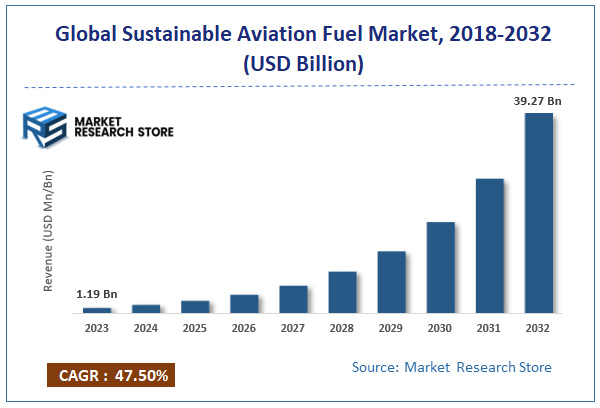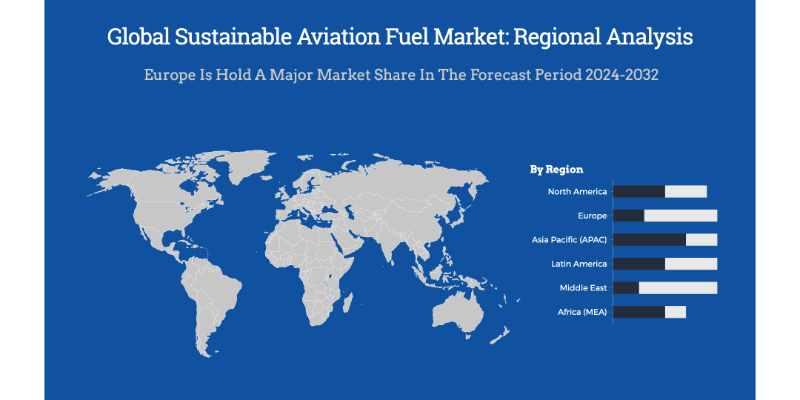Sustainable Aviation Fuel Market Size, Share, and Trends Analysis Report
CAGR :

| Market Size 2023 (Base Year) | USD 1.19 Billion |
| Market Size 2032 (Forecast Year) | USD 39.27 Billion |
| CAGR | 47.50% |
| Forecast Period | 2024 - 2032 |
| Historical Period | 2018 - 2023 |
Global Sustainable Aviation Fuel Market: Insights
According to the report published by Market Research Store, the global Sustainable Aviation Fuel Market size was valued at USD 1.19 billion in 2023 and is predicted to reach USD 39.27 billion by the end of 2032. The market is expected to grow with a CAGR of 47.50% during the forecast period. The report analyzes the global Sustainable Aviation Fuel Market’s growth drivers, restraints, and impact on demand during the forecast period. It will also help navigate and explore the arising opportunities in the Sustainable Aviation Fuel Market industry.

To Get more Insights, Request a Free Sample
Global Sustainable Aviation Fuel Market: Overview
Sustainable aviation fuel is a different form of fuel that is made to be utilized in the aircraft which simultaneously also enhances the efficiency of aircrafts. These fuels are made from sustainable feedstock which appears very similar in chemistry to conventional fossil jet fuel. The growing applications of sustainable aviation fuels led to lower carbon emissions when compared to traditional fuels as their substitute life cycle of fuel. The aviation sector is highly inclined towards lowering carbon footprints to reach a sustainable environment and effectively fulfill the stringent regulatory standards requirements.
However, several options were adopted to improve their aero-engine efficiency but stainable aviation has emerged as the most reliable and feasible solution in regard to economic and social benefits.
Global Sustainable Aviation Fuel Market: Growth Factors
The ever-expanding commercial fleets across the aviation sector due to the surge in air travel are one of the primary reasons driving the growth of the global sustainable aviation fuel market. The surge in large and massive fleets is posing a huge demand for sustainable aviation fuels as an innovative solution for lowering the greenhouse gas emission. Sustainable aviation fuels are a vital component satisfying the aviation sector’s commitment to lowering carbon emissions from traffic growth. It offers a reduction of up to 80% emission in CO2 when compared to fossil fuels.
However, sustainable aviation fuel when coupled with petroleum-based fuel becomes completely fungible drop-in fuels. These are also referred to as synthetic fuels, conventional bio-jet fuel, green fuels, renewable jet fuels, or alternative jet fuels on the basis of processes, feedstock, and technological pathways utilized in production. Such fuels are not effectively treated distinctly but still save on infrastructure costs. The cumulative efforts to utilize the existing infrastructure and equipment with other streams to approach low capital cost is likely to further expedite the growth of the global market. The drop in fuel seems to be equivalent to conventional jet fuels which can be easily used in existing infrastructure and interest without any advancements or modifications.
Such requirements are vital for general usage, safety, and low carbon footprint emission in the aviation sector. The growing disposable income of the people globally is significantly empowering people with the capabilities to access air transportation easily, therefore it is one of the primary reasons for the growth of the global sustainable aviation fuel market. Nowadays, people prefer to travel more by air than any other conventional transportation modes like road and sea. The comfortable customer experience throughout the journey also entices the customers. The spike in the consumption of synthetic lubricants supplements globally is also complimenting the growth.
In addition, the high demand for lightweight low-density lubricants is likely to create several lucrative growth opportunities in the global sustainable aviation fuel market in the forthcoming years.
Key Insights
- As per the analysis shared by our research analyst, the global Sustainable Aviation Fuel Market is estimated to grow annually at a CAGR of around 47.50% over the forecast period (2024-2032).
- In terms of revenue, the global Sustainable Aviation Fuel Market size was valued at around USD 1.19 Billion in 2023 and is projected to reach USD 39.27 Billion by 2032.
- Based on the platform, The commercial aviation sector leads due to the increasing adoption of SAF by airlines aiming to reduce carbon emissions and meet sustainability goals.
- Based on the biofuel blending capacity, This blending range is favored for its compatibility with existing aircraft engines and fuel infrastructure, balancing performance and sustainability.
- Based on the biofuel manufacturing technology, HEFA-SPK is the most commercially mature and widely adopted technology for SAF production, benefiting from established supply chains and regulatory approvals.
- Based on the fuel type, Biofuels are leading due to their lower lifecycle carbon emissions and increasing availability from various feedstocks.
- Based on the region, Western Europe's dominance is attributed to stringent environmental regulations, strong governmental support, and significant investments in SAF infrastructure.
Sustainable Aviation Fuel Market: Report Scope
| Report Attributes | Report Details |
|---|---|
| Report Name | Sustainable Aviation Fuel Market Research Report |
| Market Size in 2023 | USD 1.19 Billion |
| Market Forecast in 2032 | USD 39.27 Billion |
| Growth Rate | CAGR of 47.50% |
| Number of Pages | 196 |
| Key Companies Covered | World Energy, SkyNRG, Sasol, Preem AB, Neste, Lanzatech, Gevo, Fulcrum Bioenergy, Avfuel Corporation, and Aemetis Inc. |
| Segments Covered | By Platform, By Biofuel Blending Capacity, By Biofuel Manufacturing Technology, By Fuel Type And By Region |
| Regions Covered | North America, Europe, Asia Pacific (APAC), Latin America, Middle East, and Africa (MEA) |
| Base Year | 2023 |
| Historical Year | 2018 to 2022 |
| Forecast Year | 2024 - 2032 |
| Customization Scope | Avail customized purchase options to meet your exact research needs. Request For Customization |
Global Sustainable Aviation Fuel Market: Segmentation

To Get more Insights, Request a Free Sample
The global sustainable aviation fuel market can be segmented into the platform, biofuel blending capacity, biofuel manufacturing technology, fuel type, and region. All the segments have been analyzed based on present and future trends and the market is estimated from 2024 to 2032.
By platform, the market can be segmented into unmanned aerial vehicles, business & general aviation, military aviation, and commercial aviation. The military aviation segment dominates the global sustainable aviation fuel market owing to the fast proliferating defense sector globally.
By biofuel blending capacity, the market can be segmented into above 50%, 30% to 50%, and below 30%.
By biofuel manufacturing technology, the market can be segmented into catalytic hydrothermolysis jet, alcohol to Jet, Fischer-tropsch synthetic paraffinic kerosene with aromatics, synthetic isoparaffin from fermented hydro processed sugar, Fischer-tropsch synthetic paraffinic kerosene, and hydro processed fatty acid ester & fatty acids.
By fuel type, the market can be segmented into power to liquid fuel, hydrogen fuel, biofuel, and others. The biofuel segment accounts for the largest share in the global sustainable aviation fuel market due to the ongoing technological advancements to commercialize the use of alternative jet fuel.
The regional segment includes the current and forecast demand for North America, Europe, Asia Pacific, Latin America, and the Middle East and Africa.
Global Sustainable Aviation Fuel Market: Regional analysis

To Get more Insights, Request a Free Sample
North America accounts for the largest share in the global sustainable aviation fuel market due to the high demand for lowering carbon emission footprint owing to the air traffic in the region. Along with this, the growing supportive policies to decarbonize aviation emissions are further likely to propel the growth of the regional market.
Asia Pacific is expected to be the fastest-growing region in the global sustainable aviation fuel market due to the ongoing technological advancements and initiatives to lower the emission of greenhouse gases. Also, the growing disposable income of the people in the region is likely to further accentuate the growth of the regional market.
Global Sustainable Aviation Fuel Market: Competitive Players
Some of the significant players in the global sustainable aviation fuel market are:
- World Energy
- SkyNRG
- Sasol
- Preem AB
- Neste
- Lanzatech
- Gevo
- Fulcrum Bioenergy
- Avfuel Corporation
- Aemetis Inc.
The Global Sustainable Aviation Fuel Market is segmented as follows:
By Platform
- Unmanned Aerial Vehicles
- Business & General Aviation
- Military Aviation
- Commercial Aviation
By Biofuel Blending Capacity
- Above 50%
- 30% To 50%
- Below 30%
By Biofuel Manufacturing Technology
- Catalytic Hydrothermolysis Jet
- Alcohol To Jet
- Fischer-tropsch Synthetic Paraffinic Kerosene With Aromatics
- Synthetic Isoparaffin From Fermented Hydro Processed Sugar
- Fischer-tropsch Synthetic Paraffinic Kerosene
- Hydro Processed Fatty Acid Ester & Fatty Acids
By Fuel
- Liquid Fuel
- Hydrogen Fuel
- Biofuel
- And Others
Global Sustainable Aviation Fuel Market: Regional Segment Analysis
- North America
- The U.S.
- Canada
- Europe
- France
- The UK
- Spain
- Germany
- Italy
- Rest of Europe
- Asia Pacific
- China
- Japan
- India
- South Korea
- Southeast Asia
- Rest of Asia Pacific
- Latin America
- Brazil
- Mexico
- Rest of Latin America
- Middle East & Africa
- GCC
- South Africa
- Rest of Middle East & Africa
What Reports Provides
- Full in-depth analysis of the parent market
- Important changes in market dynamics
- Segmentation details of the market
- Former, on-going, and projected market analysis in terms of volume and value
- Assessment of niche industry developments
- Market share analysis
- Key strategies of major players
- Emerging segments and regional markets
- Testimonials to companies in order to fortify their foothold in the market.
Frequently Asked Questions
Table Of Content
Inquiry For Buying
Sustainable Aviation Fuel
Request Sample
Sustainable Aviation Fuel
